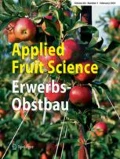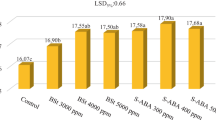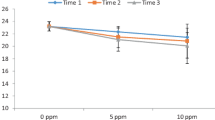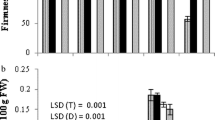Abstract
‘Crimson Seedless’ is a red seedless table grape (Vitis vinifera) and although it is widely cultivated in Aegean Region, it does not develop adequate color in warm climate. The present study was carried out to estimate the effect of abscisic acid (S-ABA), ethephon and girdling on color of bunches and metabolic profile on ‘Crimson Seedless’ grapevine variety. To achieve this goal, experimental treatments were carried out during two successive seasons (2017–2018). Experimental materials were eight-year-old ‘Crimson Seedless’ grapevines grafted onto 1103P (V. berlandieri x V. rupestris) of similar vigor and grown in a loamy soil structure under drip irrigation system.
In this study a randomized block experimental design with three replications was used, with each plot consisting of six grapevines. Exogenous plant growth regulator (PGR) like S‑ABA and Ethephon was applied to the plant materials in five different application method. T4 (S-ABA+ Ethephon) application for ‘Crimson Seedless’ grape among different applications yielded more effective results on maturity index (SS/TA), total soluble solids (°Brix), a*, CIRG (Color Index of Red Grapes) and cluster lenght (mm) properties than other applications. Exogenous S‑ABA+ Ethephon promoted color development in ‘Crimson Seedless’ grape berries. For this reason, it has been determined that T4 (S-ABA+ Ethephon) treatment gives the best results for “Crimson Seeddless” grape variety. These results indicate that ‘Crimson Seedless’ grapevines grown in a warm climate, where color development is poor, would benefit from a spray of 400 mg/L S‑ABA, ten days after the veraison and 500 mg/L Ethephon, ten days after the first S‑ABA application.








Similar content being viewed by others
References
Ban Y, Ishimaru M, Kobayashi S, Shiozaki S, Gotoyamamoto N, Horiuchi S (2003) Abscisic acid and 2,4 dichlorophenoxyacetic acid affect the expression of anthocyanin biosynthetic pathway genes in “Kyoho” grape berries. J Hortic Sci Biotechnol 78:586–589
Camara M, Diez C, Torija ME (1996) Free sugars determination by HPLC in pineapple products. Z Lebensm Unters Forsch 202(3):233–237
Cantin CM, Fidelibus MW, Crisosto CH (2007) Application of abscisic acid (ABA) advanced red color development and maintained postharvest quality of ‘Crimson Seedless’ grapes. Postharvest Biol Technol 46:237–241
Carreño J, Almela L, Martinez A, Fernández-López JA (1996) Chemotaxonomical classification of red table grapes based on anthocyanin profile and external colour. Lebensm Wiss Technol 30:259–265
Carreño J, Faraj S, Martinez A (1998) Effects of girdling and covering mesh on ripening, colour and fruit characteristics of “Italia” grapes. J Hortic Sci Biotechnol 73(1):103–106
Conde C, Silva P, Fontes N, Dias A, Tavares R, Sousa M, Agass A, Delrot S, Geros H (2007) Biochemical changes throughout grape berry development and fruit and wine quality. Nahrung 1:1–22
Davies C, Bottcher C (2009) Hormonal control of grape berry ripening. In: Roubelakis-Angelakis A (ed) Grapevine molecular physiology & biotechnology. Springer, Dordrecht, pp 229–261
Dokoozlian N, Peacock B, Luvisi D (1993) Cultural practices for Crimson Seedless table grapes. https://cetulare.ucdavis.edu/pubgrape/tb1600.pdf. Accessed 01.01.2019
Dokoozlian NK, Hirschfeld DJ (1995) The influence of cluster thinning at various stages of fruit development on “Flame Seedless” table grapes. Am J Enol Vitic 46:429–436
Dokoozlian NK, Luvisi DA, Schrader PL, Moriyama MM (1994) Influence of trunk girdle timing and ethephon on the quality of Crimson Seedless table grapes. In: Proceedings of the International Symposium on table grapes production Anaheim, 28–29 June, pp 237–240
Downey MO, Dokoozlian NK, Krstic MP (2006) Cultural practice and environmental impacts on flavonoid composition of grapes and wine: a review of recent research. Am J Enol Vitic 57:257–268
Ferrara G, Brunetti G (2008) Influence of foliar applications of humic acids on yield and fruit quality of table grape cv. Italia. J Int Sci Vigne Vin 42:79–87
Ferrara G, Brunetti G (2010) Effects of the times of application of a soil humic acid on berry quality of table grape (Vitis vinifera L.) cv Italia. Span J Agric Res 8:817–822
Ferrara G, Matarrese AMS, Pacucci C, Pacifico A, Gambacorta G, Faccia M, Trani A, Gallo V, Cafagna I, Mastrorilli P (2013) Application of abscisic acid (S-ABA) to ‘Crimson Seedless’ grape berries in a mediterranean climate: effects on color, chemical characteristics, metabolic profile, and S‑ABA concentration. J Plant Growth Regul 32:491–505. https://doi.org/10.1007/s00344-012-9316-2
Fortea MI, López-Miranda S, Serrano-Martínez A, Carreño J, Núñez-Delicado E (2009) Kinetic characterisation and thermal inactivation study of polyphenol oxidase and peroxidase from table grape (Crimson Seedless). Food Chem 113:1008–1014. https://doi.org/10.1016/j.foodchem.2008.08.053
Francisco JDN, Adilson PJ, Cristine VB, Silvia RC, Daniel C, Giuseppina PPL, Sergio RR, Sarita L, Marco AT (2017) The exogenous application of Abscisic acid induce accumulation of Anthocyanins and phenolic compounds of the “Rubi” grape. Am J Plant Sci 8:2422–2432
Hiratsuka S, Onodera H, Kawai Y, Kubo T, Itoh H, Wada R (2001) ABA and sugar effects on anthocyanin formation in grape berry cultured in vitro. Sci Hortic 90:121–130
Jeong ST, Goto-Yamamoto N, Kobayashi S, Esaka M (2004) Effects of plant hormones and shading on the accumulation of anthocyanins and the expression of anthocyanin biosynthetic genes in grape berry skins. Plant Sci 167:247–252
Kataoka I, Sugiura A, Utsunomiya N, Tomana T (1982) Effect of abscisic acid and defoliation on anthocyanin accumulation in Kyoho grapes (Vitis vinifera L. X V. labruscana Bailey). Vitis 21:325–332
Kliewer WM (1977) Influence of temperature, solar radiation and nitrogen on coloration and composition of Emperor grapes. Am J Enol Vitic 28:96–103
Koshita Y, Asakura T, Fukud H, Tsuchida Y (2007) Nighttime temperature treatment of fruit clusters of “Aki Queen” grapes during maturation and its effect on the skin color and abscisic acid content. Vitis 46:208–209
Lavado N, Uriarte D, La Mancha, Moreno D, Valdés E, Prieto MH (2019) Effect of forcing vine regrowth on “Tempranillo” (Vitis vinifera L.) berry development and quality in Extremadura. Vitis 58(Special Issue):135–142. https://doi.org/10.5073/vitis.2019.58.special-issue
Lund ST, Peng FY, Nayar T, Reid KE, Schlosser J (2008) Gene expression analyses in individual grape (Vitis vinifera L.) berries during ripening initiation reveal that pigmentation intensity is a valid indicator of developmental staging within the cluster. Plant Mol Biol 68:301–315
Lurie S, Ovadi R, Nissim-Levi A, Oren-Shamir M, Kaplunov T, Zutahy Y, Weksler H, Lichter A (2009) Abscisic acid improves color development in ‘Crimson Seedless’ grapes in the vineyard and on detached berries. J Hortic Sci Biotechnol 84:639–644
Muñoz-Robredo P, Robledo P, Manríquez D, Molina R, Defilippi BG (2011) Characterization of sugars and organic acids in commercial varieties of table grapes. Chil J Agric Res 71(3):452–458
Ovadia R, Oren-Shamir M, Kaplunov T, Zutahy Y, Lichter A, Lurie S (2013) Effects of plant growth regulators and high temperature on colour development in ‘Crimson Seedless’ grapes. J Hortic Sci Biotechnol 88(4):387–392. https://doi.org/10.1080/14620316.2013.11512980
Peppi MC, Fidelibus MW (2008) Effects of chlorfenuron and abscisic acid on the quality of “Flame Seedless” grapes. HortScience 43:173–176
Peppi MC, Fidelibus MW, Dokoozlian N (2006) Abscisic acid application timing and concentration affect firmness, pigmentation and color of “Flame Seedless” grapes. HortScience 41:1440–1445
Peppi MC, Fidelibus MW, Dokoozlian N (2007a) Application timing and concentration of abscisic acid affect the quality of “Redglobe” grapes. J Hortic Sci Biotechnol 82:304–310
Peppi MC, Fidelibus MW, Dokoozlian N (2007b) Timing and concentration of abscisic acid affect the quality of ‘Crimson Seedless’ grapes. Int J Fruit Sci 7:71–83
Peppi MC, Fidelibus MW, Dokoozlian NK (2008) Timing and concentration of abscisic acid applications affect the quality of ‘Crimson Seedless’ grapes. Int J Fruit Sci 7(4):71–83. https://doi.org/10.1080/15538360802003324
Sandhu AK, Gray DJ, Lu J, Gu L (2011) Effects of exogenous abscisic acid on antioxidant capacities, anthocyanins, and flavonol contents of muscadine grape (Vitis rotundifolia) skins. Food Chem 126:982–988
Sen İlknur, Tokatli F (2014) Authenticity of wines made with economically important grapevarieties grown in Anatolia by their phenolic profiles. Food Control 46:446–454
Souza Leão PC, Lima MAC, Costa JPD, Trindade DCG (2015) Abscisic acid and Ethephon for improving red color and quality of Crimson Seedless grapes grown in a tropical region. Am J Enol Vitic 66(1):37–45. https://doi.org/10.5344/ajev.2014.14041
Spayd SE, Tarara JM, Mee DL, Ferguson JC (2002) Separation of sunlight and temperature effects on the composition of Vitis vinifera cv. Merlot berries. Am J Enol Viticult 53:171–182
Thaiponga K, Boonprakoba U, Crosbyb K, Zevallosc CL, Hawkins BD (2006) Comparison of ABTS, DPPH, FRAP, and ORAC assays for estimating antioxidant activity from guava fruit extracts. J Food Compost Anal 19:669–675. https://doi.org/10.1016/j.jfca.2006.01.003
Yamane T, Jeong ST, Goto-Yamamoto N, Koshita Y, Kobayashi S (2006) Effects of temperature on anthocyanin biosynthesis in grape berry skins. Am J Enol Vitic 57:54–59
Acknowledgements
The authors thank Sumi Agro for kindly providing the Protone and Ethephone.
Author information
Authors and Affiliations
Corresponding author
Ethics declarations
Conflict of interest
B. İşçi, E. Kacar and A. Altındişli declare that they have no competing interests.
Rights and permissions
About this article
Cite this article
İşçi, B., Kacar, E. & Altındişli, A. The Effects of Some Exogenous Applications on Quality in ‘Crimson Seedless’ Grape. Erwerbs-Obstbau 62 (Suppl 1), 87–100 (2020). https://doi.org/10.1007/s10341-020-00502-0
Received:
Accepted:
Published:
Issue Date:
DOI: https://doi.org/10.1007/s10341-020-00502-0




